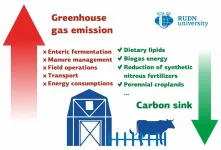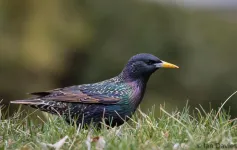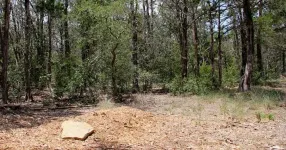(Press-News.org) With the COVID-19 pandemic entering its second year, the challenges faced both by individuals and nations remain substantial. While notable medical advancements in the treatment of COVID-19 have been made, a host of questions about how to live with it and how to work to end it remain active.
Carnegie Mellon University researchers David Rode and Paul Fischbeck explore these questions in a new article, "On ambiguity reduction and the role of decision analysis during the pandemic," published in a special issue of the journal END
Making good decisions about COVID-19
The COVID-19 pandemic isn't just a challenge for medicine, it's a challenge for decision making of all types
2021-02-09
ELSE PRESS RELEASES FROM THIS DATE:
Relaxed precautions, not climate, the biggest factor driving wintertime COVID-19 outbreaks
2021-02-09
Wintertime outbreaks of COVID-19 have been largely driven by whether people adhere to control measures such as mask wearing and social distancing, according to a study published Feb. 8 in Nature Communications by Princeton University researchers. Climate and population immunity are playing smaller roles during the current pandemic phase of the virus, the researchers found.
The researchers -- working in summer 2020 -- ran simulations of a wintertime coronavirus outbreak in New York City to identify key factors that would allow the virus to proliferate. They found that relaxing control measures in the summer months led to an outbreak in the winter regardless of climate factors.
"Our results implied that lax control measures -- and likely ...
Ancient Amazonian farmers fortified valuable land they had spent years making fertile to protect it
2021-02-09
Ancient Amazonian communities fortified valuable land they had spent years making fertile to protect it from conflict, excavations show.
Farmers in Bolivia constructed wooden defences around previously nutrient-poor tropical soils they had enriched over generations to keep them safe during times of social unrest.
These long-term soil management strategies allowed Amazonians to grow nutrient demanding crops, such as maize and manioc and fruiting trees, and this was key to community subsistence. These Amazonian Dark Earths, or Terra Preta, were created through burning, mulching, and the deposition of organic waste.
It was known that some communities built ditches ...
RUDN University ecologist suggested a way to reduce greenhouse gas emissions in animal farming
2021-02-09
An ecologist from RUDN University suggested a method to evaluate and reduce the effect of animal farms on climate change and developed a set of measures for small farms that provides for the complete elimination of greenhouse gas emissions. The results of the study were published in the Journal of Cleaner Production.
Crop and animal farming and other agricultural activities account for almost a quarter of all greenhouse gases produced by humanity and therefore add a lot to climate change. On the other hand, the soils and biomass accumulate a lot of carbon, thus preventing it from getting into the atmosphere as a part of carbon dioxide and slowing climate change down. An ecologist from RUDN University suggested ...
Starling success traced to rapid adaptation
2021-02-09
Ithaca, NY--Love them or hate them, there's no doubt the European Starling is a wildly successful bird. A new study from the Cornell Lab of Ornithology examines this non-native species from the inside out. What exactly happened at the genetic level as the starling population exploded from just 80 birds released in New York City's Central Park in 1890, peaking at an estimated 200 million breeding adults spread all across North America? The study appears in the journal Molecular Ecology.
"The amazing thing about the evolutionary changes among starling populations ...
Lipid composition of microalgae of the Kaliningrad Region was determined
2021-02-09
The term "algae" is used to refer to over 72,500 identified aquatic species. The size of algae is up to tens of meters, however, most (about 80%) of the species are much smaller - they comprise the microalgae group. Microalgae are rich in nutrients and biologically active substances such as proteins, carbohydrates, lipids, vitamins, pigments and others. These components are widely used in food, cosmetic, chemical and energy industries. Biotechnology of microalgae has multiple advantages: they are a renewable and sustainable resource, more productive than terrestrial plants due to their high growth rate and lack of seasonality ...
Researchers study how lifelong environmentalists want their remains handled after death
2021-02-09
LAWRENCE -- Traditional burial in a graveyard has environmental costs. Graves can take up valuable land, leak embalming chemicals and involve nonbiodegradable materials like concrete, as well as the plastic and steel that make up many caskets. But the other mainstream option -- cremation -- releases dangerous chemicals and greenhouse gasses into the environment.
So, what's an environmentalist to do when making plans for the end of life?
A new study from the University of Kansas in the journal Mortality details how older environmentalists consider death care and how likely they are to choose "green" burials and other eco-friendly options.
"This article is specifically asking if older adult environmentalists consider how their bodies are going to ...
Human eye beats machine in archaeological color identification test
2021-02-09
GAINESVILLE, Fla. --- A ruler and scale can tell archaeologists the size and weight of a fragment of pottery - but identifying its precise color can depend on individual perception. So, when a handheld color-matching gadget came on the market, scientists hoped it offered a consistent way of determining color, free of human bias.
But a new study by archaeologists at the Florida Museum of Natural History found that the tool, known as the X-Rite Capsure, often misread colors readily distinguished by the human eye.
When tested against a book of color chips, the machine failed to produce correct color scores in 37.5% of cases, even though its software system included the same set of chips. In an analysis of fired ...
Collective worm and robot 'blobs' protect individuals, swarm together
2021-02-09
Individually, California blackworms live an unremarkable life eating microorganisms in ponds and serving as tropical fish food for aquarium enthusiasts. But together, tens, hundreds, or thousands of the centimeter-long creatures can collaborate to form a "worm blob," a shape-shifting living liquid that collectively protects its members from drying out and helps them escape threats such as excessive heat.
While other organisms form collective flocks, schools, or swarms for such purposes as mating, predation, and protection, the Lumbriculus variegatus worms are unusual in their ability to braid themselves together to accomplish tasks that unconnected individuals cannot. A new study reported by researchers at ...
New CRISPR tech targets human genome's complex code
2021-02-09
HOUSTON - (Feb. 9, 2021) - Finding a needle in a haystack is hard enough. But try finding a specific molecule on the needle.
Rice University researchers have achieved something of the sort with a new genome editing tool that targets the supporting players in a cell's nucleus that package DNA and aid gene expression. Their work opens the door to new therapies for cancer and other diseases.
Rice bioengineer Isaac Hilton, postdoctoral researcher and lead author Jing Li and their colleagues programmed a modified CRISPR/Cas9 complex to target specific histones, ubiquitous epigenetic proteins that keep DNA in order, ...
Astronomers offer possible explanation for elusive dark-matter-free galaxies
2021-02-09
RIVERSIDE, Calif. -- A team led by astronomers at the University of California, Riverside, has found that some dwarf galaxies may today appear to be dark-matter free even though they formed as galaxies dominated by dark matter in the past.
Galaxies that appear to have little to no dark matter -- nonluminous material thought to constitute 85% of matter in the universe -- complicate astronomers' understanding of the universe's dark matter content. Such galaxies, which have recently been found in observations, challenge a cosmological model used by astronomers called Lambda Cold Dark Matter, or LCDM, where all galaxies are surrounded by a massive and extended dark matter halo.
Dark-matter-free galaxies are not well understood in the astronomical community. ...
LAST 30 PRESS RELEASES:
Do our body clocks influence our risk of dementia?
Anthropologists offer new evidence of bipedalism in long-debated fossil discovery
Safer receipt paper from wood
Dosage-sensitive genes suggest no whole-genome duplications in ancestral angiosperm
First ancient human herpesvirus genomes document their deep history with humans
Why Some Bacteria Survive Antibiotics and How to Stop Them - New study reveals that bacteria can survive antibiotic treatment through two fundamentally different “shutdown modes”
UCLA study links scar healing to dangerous placenta condition
CHANGE-seq-BE finds off-target changes in the genome from base editors
The Journal of Nuclear Medicine Ahead-of-Print Tip Sheet: January 2, 2026
Delayed or absent first dose of measles, mumps, and rubella vaccination
Trends in US preterm birth rates by household income and race and ethnicity
Study identifies potential biomarker linked to progression and brain inflammation in multiple sclerosis
Many mothers in Norway do not show up for postnatal check-ups
Researchers want to find out why quick clay is so unstable
Superradiant spins show teamwork at the quantum scale
Cleveland Clinic Research links tumor bacteria to immunotherapy resistance in head and neck cancer
First Editorial of 2026: Resisting AI slop
Joint ground- and space-based observations reveal Saturn-mass rogue planet
Inheritable genetic variant offers protection against blood cancer risk and progression
Pigs settled Pacific islands alongside early human voyagers
A Coral reef’s daily pulse reshapes microbes in surrounding waters
EAST Tokamak experiments exceed plasma density limit, offering new approach to fusion ignition
Groundbreaking discovery reveals Africa’s oldest cremation pyre and complex ritual practices
First breathing ‘lung-on-chip’ developed using genetically identical cells
How people moved pigs across the Pacific
Interaction of climate change and human activity and its impact on plant diversity in Qinghai-Tibet plateau
From addressing uncertainty to national strategy: an interpretation of Professor Lim Siong Guan’s views
Clinical trials on AI language model use in digestive healthcare
Scientists improve robotic visual–inertial trajectory localization accuracy using cross-modal interaction and selection techniques
Correlation between cancer cachexia and immune-related adverse events in HCC
[Press-News.org] Making good decisions about COVID-19The COVID-19 pandemic isn't just a challenge for medicine, it's a challenge for decision making of all types






